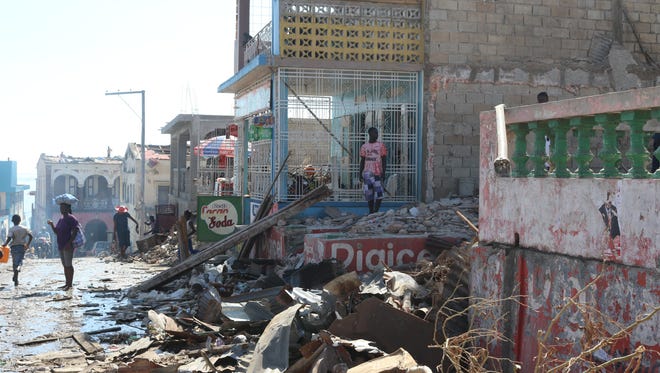In hurricane-battered Haiti, small steps to recovery 3 weeks after Matthew

Three weeks after ferocious Hurricane Matthew pounded Haiti, pockets of progress are visible on the battered Caribbean island — but the situation remains grave.
Aid groups say they have made headway getting emergency medicine and food to the hardest-hit areas. Many inaccessible roads have reopened, including one key artery from the capital of Port-au-Prince to Jérémie, a coastal town ravaged by the Oct. 4 storm.
Cellphone service is restored. And the distribution of emergency supplies is in high gear.
"We've come a long way in just two or three weeks after this massive devastation," said Marielle Sander, the United Nations Population Fund representative in Haiti.
The Category 4 hurricane slammed Haiti with 145-mph winds, killing 546 people and injuring 438, according to the country's Directorate of Civil Protection. Some news media reports put the death toll near 1,000; the real number may never be known.
Other statistics are still sobering: About 175,000 people remain homeless, according to the government, and the U.N. says 1.4 million need food assistance.
"Definitely progress is being made, but in some areas more than others" said Mike Weickert, director of World Vision's Haiti team. His humanitarian group has already reached 32,000 people. "But it is not going as fast as we want. We want to double distribution capacity," he said.
How you can help Haiti after Hurricane Matthew
Even though the route to Jérémie has reopened, Sander recently saw "10 various forms of roadblocks," such as toppled trees or desperate people trying to divert food deliveries. Some trucks have been looted, she said.

The destruction in Jérémie is staggering, Sander said. "It was the most beautiful place on the coast, a Caribbean dream with swaying palm trees. Now it looks like a war zone ... like the entire city has been put in a blender."
Even during the chaos, Haitians soldiered on. Sander recalled a midwife in Jérémie who delivered six babies during the height of the storm "with water up to her knees."
"Haitians are the most resilient people on Earth," she said.
World Vision has focused on providing shelter and necessities: blankets, mosquito nets, hygiene kits, tarps or tents, Weickert said. Also critical are buckets to store clean water — essential as the country battles a deadly cholera outbreak. At least 2,271 suspected cases of cholera are on the island, the government said.
Adding to the overwhelming woes were last week's torrential rains that swamped parts of Les Cayes. Jessica Pearl, country director for Mercy Corps, said Friday's rain re-flooded many areas hit by the hurricane, making roads impassable and halting aid distributions. "People were tired, or even exhausted, and here we are now dealing with a second round of flooding," she said.
The World Food Programme has been dropping parcels from helicopters or delivering supplies by boat to remote regions.
"Access to the hardest-hit areas remains an issue," said Michel Rooijackers, with Save the Children. "Our mobile health team has to walk more than 1 mile with supplies in order to reach a clinic we are running in Tibi."
Voices: After Hurricane Matthew, don't forget Haiti
Planting season — the livelihood for many Haitians — starts in November, "and things should be in the ground by December," Weickert said. Haitians will need "access to seeds and tools to plant a good crop."
Schools also need help. Some have reopened, but supplies are often damaged and books are lost. Buildings have structural damage. "Giving kids normalcy and a chance to learn is critical," Weickert said.
Sander's group focuses on "things less talked about: access to health care for pregnant women, protection of women and girls who have been displaced."
Some daily routines have resumed. "Markets are bouncing back. People are getting on with their lives, trying to get a roof over their heads, going back to work if they can," Weickert said.

Delivering Haiti from this latest crisis — after a major earthquake five years ago — will be an arduous task, requiring a long-term commitment from the international community, relief workers said. "The level of funding available to Haiti is woefully insufficient for the scale of devastation," Pearl said.
Andrew MacCalla, with Direct Relief, which distributed supplies and 15.5 million doses of medicine in the past three weeks, described flying by helicopter into a village west of Les Cayes.
"We could see from above that the whole village was totally wiped out. A small village with a couple hundred households, and all the houses are gone," he said. "The first week, they were all sleeping inside the walls of this clinic, a birthing clinic, the only one for hundreds of miles. And their roof was also blown off, but it was still a better place to sleep."
Hundreds of people came out "of seemingly nowhere" when the helicopter landed.
"It will be $35,000 just for them to rebuild and get back up and running again — just that one clinic," he said. "A small birthing clinic in a small town, not even directly in the storm’s path."
Follow Miller on Twitter @susmiller
